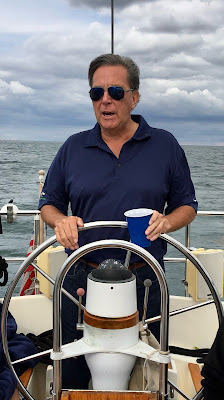 |
| "Dizzy," by Marc Klionsky (1988; National Portrait Gallery—Smithsonian Institute) |
Dizzy Gillespie cut a regal figure striding through O’Hare: his black and red fez like a crown, his green raincoat draped over his shoulders like a cape.
It was 1988. Dizzy was coming in from Paris. My job was to meet him at the airport, fly down to Peoria together, interview the jazz legend and catch his performance that night. He didn’t bring anything so square as a change of clothes. Just an instrument case containing his famous angled horn. And a small satchel holding papers, vitamins and medicine for his diabetes.
If the name is unfamiliar — time effaces the greatest fame — Dizzy Gillespie was the archetypal jazzman. His personal look — sunglasses, soul patch, beret — became the cliche of a bee-bop hipster.
The musician had come quite a way — 4,300 miles, Paris to New York by supersonic Concorde, New York to Chicago by jet, now a prop plane to the city known as the place where anything daring won’t play. He was 71 years old. He’d been blowing his horn for half a century. Why go to all this trouble for another gig?
“I want to play all the time,” he replied. “You have trouble if you lay off. There’s an old saying among classical jazz guys: “If I don’t play one day, I know it. If I don’t play two days, my compatriots know it. If I don’t play three days, the whole world knows it.”
“You have trouble if you lay off.” Something to bear in mind as the Chicago Jazz Festival takes place this weekend at full strength for the first time in three years — last year was a one-night showcase. I imagine more than a few people have a little trouble with the notion of heading to downtown Chicago simply for great, free jazz. Perhaps out of practice by the COVID lull, perhaps given pause by violence that has spilled out of the areas of the city where Chicago has accustomed itself, shamefully, to allowing violence to perennially persist.
It was 1988. Dizzy was coming in from Paris. My job was to meet him at the airport, fly down to Peoria together, interview the jazz legend and catch his performance that night. He didn’t bring anything so square as a change of clothes. Just an instrument case containing his famous angled horn. And a small satchel holding papers, vitamins and medicine for his diabetes.
If the name is unfamiliar — time effaces the greatest fame — Dizzy Gillespie was the archetypal jazzman. His personal look — sunglasses, soul patch, beret — became the cliche of a bee-bop hipster.
The musician had come quite a way — 4,300 miles, Paris to New York by supersonic Concorde, New York to Chicago by jet, now a prop plane to the city known as the place where anything daring won’t play. He was 71 years old. He’d been blowing his horn for half a century. Why go to all this trouble for another gig?
“I want to play all the time,” he replied. “You have trouble if you lay off. There’s an old saying among classical jazz guys: “If I don’t play one day, I know it. If I don’t play two days, my compatriots know it. If I don’t play three days, the whole world knows it.”
“You have trouble if you lay off.” Something to bear in mind as the Chicago Jazz Festival takes place this weekend at full strength for the first time in three years — last year was a one-night showcase. I imagine more than a few people have a little trouble with the notion of heading to downtown Chicago simply for great, free jazz. Perhaps out of practice by the COVID lull, perhaps given pause by violence that has spilled out of the areas of the city where Chicago has accustomed itself, shamefully, to allowing violence to perennially persist.
To continue reading, click here.



























